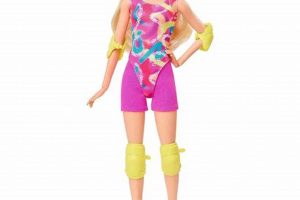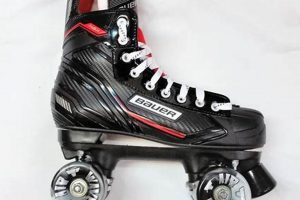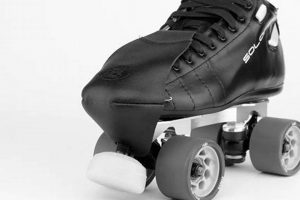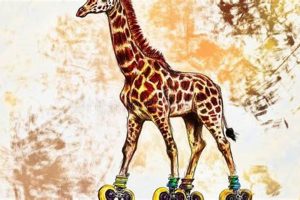Apparel and accessories designed for use during recreational or competitive roller skating constitute a specialized ensemble. This typically includes clothing that allows for freedom of movement and protective gear such as helmets, knee pads, elbow pads, and wrist guards. An example would be fitted athletic wear paired with a helmet and full set of pads for safety and performance.
The selection of appropriate attire offers significant advantages. Protective equipment mitigates the risk of injury from falls, while suitable clothing enhances comfort and maneuverability. Historically, the evolution of garments used in roller skating has mirrored advancements in both safety technology and athletic wear design, reflecting a greater emphasis on both protection and performance.
The following sections will delve into the specifics of selecting optimal protective equipment, explore diverse apparel options suitable for various skating styles, and provide guidance on maintaining both the skates themselves and the associated gear for long-term use and safety.
Essential Considerations for Skating Attire
The selection of appropriate clothing and safety equipment is crucial for a safe and enjoyable roller skating experience. The following guidelines provide essential considerations for optimizing protective measures and ensuring comfort during skating activities.
Tip 1: Prioritize Head Protection: A properly fitted helmet certified by a recognized safety standard organization, such as ASTM or CPSC, is non-negotiable. Ensure the helmet sits level on the head, covering the forehead, and is securely fastened.
Tip 2: Implement Joint Protection: Knee pads, elbow pads, and wrist guards significantly reduce the risk of abrasions, fractures, and dislocations. Select pads that fit snugly without restricting movement, and that cover the entire joint area.
Tip 3: Choose Durable Fabrics: Opt for clothing made from abrasion-resistant materials like denim, canvas, or synthetic blends. These fabrics offer increased protection in the event of a fall and withstand the wear and tear associated with skating.
Tip 4: Maintain Freedom of Movement: Avoid restrictive clothing that limits range of motion. Loose-fitting pants, shorts, or leggings allow for unrestricted movement and facilitate proper skating technique.
Tip 5: Consider Visibility: When skating in low-light conditions or on roadways, wear bright-colored clothing or reflective gear to enhance visibility and reduce the risk of accidents. Consider reflective tape on the attire to make you more visible.
Tip 6: Adapt to Environmental Conditions: Dress appropriately for the weather. In warm weather, wear breathable fabrics that wick away moisture. In cold weather, layer clothing to maintain warmth without restricting movement.
Tip 7: Inspect Gear Regularly: Before each skating session, thoroughly inspect all protective gear for signs of wear, damage, or loose straps. Replace any damaged or worn-out equipment immediately to ensure optimal protection.
Adhering to these guidelines will significantly enhance safety and comfort during roller skating activities, promoting a more positive and injury-free experience.
The subsequent sections will explore specific types of roller skates and maintenance practices to ensure their longevity and performance.
1. Protection
The incorporation of protective elements within skating attire is a fundamental imperative, directly influencing the mitigation of potential injuries. The selection of appropriate gear, such as helmets, wrist guards, elbow pads, and knee pads, serves as the primary defense against impact forces generated during falls or collisions. For instance, head injuries, a common risk in skating, can be significantly reduced by utilizing helmets adhering to established safety standards like CPSC or ASTM. The cause-and-effect relationship is direct: inadequate protection leads to increased risk of injury, while comprehensive protection demonstrably lowers that risk.
The practical significance extends beyond the immediate prevention of physical harm. Regular employment of protective gear fosters a sense of confidence, enabling skaters to explore their abilities without undue apprehension. Consider a novice skater learning to execute a new maneuver; the presence of knee and elbow pads allows them to attempt the skill with reduced fear of abrasions or more serious joint trauma. Furthermore, the long-term implications of neglecting protection can include chronic pain, reduced mobility, and costly medical interventions. Conversely, consistent adherence to protective measures promotes a sustained engagement with skating, enhancing both physical and mental well-being.
In summary, the intersection of protection and skating attire represents a critical nexus for skater safety. While the ideal setup of skating gear varies based on the level of expertise, or skater needs the core concept remains constant: prioritizing protective elements through informed equipment selection, proper fitment, and consistent utilization is essential for minimizing injury risks and facilitating a positive and sustainable skating experience. The ongoing challenges lie in promoting widespread awareness of safety standards and fostering a culture of responsible skating practices.
2. Comfort
Adequate comfort within a roller skating ensemble is a crucial factor influencing both performance and endurance. Discomfort can lead to distractions, reduced focus, and premature fatigue, hindering the skater’s ability to execute maneuvers effectively and potentially increasing the risk of accidents. For instance, poorly fitting skates or restrictive clothing can cause blisters, chafing, and muscle strain, all of which detract from the skating experience. The selection of breathable fabrics, properly sized protective gear, and well-fitting skates directly contribute to skater comfort and, consequently, improved performance.
The relationship between comfort and skater ability extends beyond mere physical sensation. When a skater is comfortable, they are more likely to relax and focus on technique, leading to smoother movements and greater control. Consider a skater practicing a complex routine; if their clothing is too tight or their skates are causing discomfort, their attention will be diverted to these issues, impeding their ability to master the skill. Conversely, a comfortable and well-fitting ensemble allows the skater to concentrate fully on the task at hand, maximizing their learning potential. The practical application of this understanding involves carefully selecting apparel and equipment that prioritize comfort, taking into account factors such as fit, material, and breathability.
In summation, comfort is an indispensable component of a well-designed roller skating ensemble, directly impacting both physical well-being and skating proficiency. While prioritizing safety remains paramount, attention to comfort significantly enhances the overall skating experience, promoting sustained engagement and reducing the likelihood of injuries caused by distraction or fatigue. The challenge lies in striking a balance between protection, performance, and comfort, ensuring that the chosen attire facilitates optimal results across all three domains.
3. Visibility
Visibility constitutes a critical safety component of any roller skating ensemble, directly influencing a skater’s detectability by other individuals and vehicles, particularly in environments with compromised lighting or dense traffic. The effectiveness of an attire’s visual profile is directly correlated with the reduction of accident risk. For example, a skater wearing dark clothing at dusk is significantly less visible to motorists than one wearing brightly colored or reflective garments. The cause-and-effect relationship is evident: diminished visibility increases the likelihood of collisions, while enhanced visibility serves as a proactive measure to mitigate such risks. The integration of high-visibility materials and strategically placed reflective elements into skating apparel is a practical application of this principle.
The practical significance of improved skater visibility extends beyond simple collision avoidance. Enhanced visibility can also improve the perception of a skater’s movements, allowing other road users to anticipate actions and react accordingly. Consider a skater navigating a shared pathway; if their attire incorporates reflective strips or luminous accents, other pedestrians and cyclists are better equipped to perceive their direction and speed. This heightened awareness promotes safer interactions and reduces the potential for misunderstandings that might lead to incidents. Furthermore, visibility-enhancing accessories, such as illuminated wristbands or LED lights attached to skates, can further augment a skater’s visual presence, particularly during nighttime or low-light skating activities.
In summary, prioritizing visibility within a roller skating ensemble is an essential safety measure that directly contributes to accident prevention and safer interactions with other road users. While factors such as protective gear and skating skill are undoubtedly important, the ability to be seen is a fundamental prerequisite for avoiding collisions. The ongoing challenge lies in promoting wider awareness of the benefits of high-visibility skating attire and encouraging skaters to adopt proactive measures to enhance their detectability in all skating environments.
4. Mobility
Mobility, in the context of roller skating attire, is a crucial performance factor dictating the range and ease of movement attainable by the skater. The design and fit of the clothing significantly impact the skater’s ability to execute maneuvers and maintain balance. Restricted mobility can lead to compromised technique and increased risk of injury.
- Fabric Flexibility
The selection of fabrics possessing inherent flexibility is paramount. Rigid or constricting materials impede the skater’s ability to bend, stretch, and twist, limiting their range of motion. Examples include the use of stretchable synthetic blends or lightweight, non-restrictive natural fibers like cotton. The implications of inflexible attire range from inhibited stride length to difficulties in performing advanced skating techniques, ultimately impacting overall performance.
- Ergonomic Design
Garment designs that accommodate the anatomical demands of skating movements are essential. This entails avoiding tight seams, restrictive waistbands, and overly bulky layers. Articulated knees in pants or leggings, for example, allow for a greater range of motion without binding. Failure to consider ergonomic principles in clothing design can result in chafing, discomfort, and a compromised ability to maintain balance during dynamic movements.
- Layering Systems
The utilization of layering systems allows skaters to adapt to varying environmental conditions while maintaining optimal mobility. Loose-fitting layers that can be easily added or removed provide insulation without restricting movement. Overly bulky or constricting layers can impede flexibility and increase the risk of overheating. Proper layering enables skaters to adjust their attire to suit the climate while preserving their ability to perform skating maneuvers effectively.
- Protective Gear Integration
The design of skating attire should facilitate seamless integration with protective gear, such as knee pads, elbow pads, and wrist guards. Clothing that interferes with the proper fit or function of protective equipment compromises both mobility and safety. Articulated designs and adjustable closures are essential for ensuring that protective gear can be worn comfortably and effectively without restricting movement. Failure to properly integrate protective gear into the skating ensemble can reduce its efficacy and increase the risk of injury.
In conclusion, the design and selection of roller skating attire must prioritize mobility to facilitate optimal performance and reduce the risk of injury. The interconnectedness of fabric flexibility, ergonomic design, layering systems, and protective gear integration directly impacts the skater’s ability to move freely and confidently. By considering these facets, skaters can select attire that enhances their overall skating experience and maximizes their potential.
5. Durability
The longevity and resistance to wear and tear inherent in a roller skates outfit, encapsulated by the term “durability,” directly impacts its lifecycle cost, safety performance, and overall suitability for its intended purpose. The selection of materials, construction techniques, and design considerations all contribute to the outfit’s ability to withstand the stresses of repetitive motion, abrasion from falls, and exposure to environmental factors. A durable outfit translates to fewer replacements, reduced expenditure over time, and consistent protection against potential injuries. Consider, for example, knee pads constructed from high-density foam encased in abrasion-resistant nylon; this design inherently provides superior protection and a longer lifespan compared to a similar product made from less robust materials.
The practical significance of durability extends beyond mere cost savings. A roller skates outfit that degrades rapidly poses a direct safety hazard. Worn-out fabrics may tear during a fall, compromising impact protection. Straps or closures that fail due to material fatigue can render protective gear ineffective. Therefore, investing in durable materials and construction is an investment in the skater’s safety and well-being. An example can be drawn from comparing budget-friendly helmets to those certified to meet rigorous safety standards. The cheaper helmet may offer superficial protection, while the certified helmet, designed and constructed for durability, can withstand significant impact forces, potentially preventing serious head injuries.
In summary, durability is an indispensable attribute of a roller skates outfit, inextricably linked to both economic considerations and safety outcomes. While initial cost may influence purchasing decisions, the long-term benefits of a durable outfit far outweigh the savings from cheaper, less robust alternatives. Challenges remain in educating consumers about the importance of material quality and construction techniques and in establishing standardized durability testing protocols for roller skating apparel and protective gear. Further development and implementation of these protocols would enable informed purchasing decisions and promote a culture of safety and longevity in the roller skating community.
6. Style
The integration of personal expression into a roller skates ensemble, referred to as “style,” serves as a multifaceted component with potential implications for both confidence and community affiliation. While safety and functionality remain paramount, the aesthetic choices made in assembling an attire reflect individual preferences and can influence a skater’s self-perception and interaction within skating groups. For example, skaters may choose specific color palettes, patterns, or garment silhouettes to align with particular subcultures within the skating community, such as retro roller derby or synchronized roller dance. The effect can be enhanced self-esteem and a sense of belonging. Style is important for creating a personal image.
The incorporation of stylistic elements is practically significant in fostering a sense of identity and encouraging participation in skating activities. Skaters who feel comfortable and confident in their appearance are more likely to engage actively and develop their skills. Moreover, distinctive stylistic choices can serve as a form of nonverbal communication, conveying aspects of personality, skill level, or group affiliation. This is evident in the competitive skating arena, where stylistic choices, such as the embellishment of costumes or the selection of music, contribute to the overall impression conveyed to judges and audiences. For instance, freestyle skaters often select clothing and accessories that complement their chosen music and accentuate the fluidity of their movements.
In conclusion, while “style” within a roller skates ensemble remains secondary to safety and functionality, its impact on individual confidence and community connection cannot be disregarded. The ability to express personal preferences through aesthetic choices can foster a more positive and engaging skating experience. Challenges lie in promoting inclusivity and discouraging judgments based solely on stylistic choices, ensuring that all skaters feel welcome and respected regardless of their individual expression. The intersection of style and performance in roller skating continues to evolve, reflecting broader trends in fashion and self-expression, making the aesthetic dimension a relevant aspect in overall enjoyment and group relation.
Frequently Asked Questions
This section addresses common inquiries regarding the selection and utilization of appropriate attire and protective gear for roller skating, focusing on safety and performance considerations.
Question 1: What constitutes a basic, recommended roller skates outfit for beginners?
A foundational ensemble includes a certified helmet (CPSC or ASTM standard), wrist guards, elbow pads, knee pads, and comfortable, non-restrictive clothing. Emphasis should be placed on proper fit and functionality of protective gear.
Question 2: Why is specific clothing recommended over everyday attire for roller skating?
Roller skating-specific attire typically offers enhanced abrasion resistance, freedom of movement, and compatibility with protective gear. Everyday attire may not provide adequate protection or flexibility, potentially increasing injury risk and hindering performance.
Question 3: How often should roller skates outfit components, particularly protective gear, be replaced?
Protective gear should be replaced immediately upon signs of damage, wear, or after a significant impact. Helmets, in particular, should be replaced after any impact, even if damage is not visibly apparent. Routine inspection is recommended before each use.
Question 4: Is there a distinction between roller skates outfits for indoor versus outdoor skating?
While the core components remain consistent, adjustments may be necessary. Outdoor skating often necessitates more robust protective gear and abrasion-resistant clothing due to potentially rougher surfaces. Visibility considerations also become more important in outdoor settings.
Question 5: Are there specific clothing materials to avoid when assembling a roller skates outfit?
Avoid overly restrictive materials such as stiff denim or non-stretch synthetics, which can limit range of motion. Similarly, loose-fitting garments with excessive fabric may pose a tripping hazard.
Question 6: How crucial is proper fit in roller skates outfit components, especially protective gear?
Proper fit is paramount for effective protection and comfort. Ill-fitting protective gear can shift during use, leaving areas vulnerable to injury. It may also impede movement, reducing control and increasing the risk of falls. Secure and comfortable fit promotes safety.
Key takeaways include the importance of prioritizing safety through proper protective equipment, selecting appropriate clothing for mobility and durability, and maintaining gear in good condition. All outfit elements should be chosen based on these criteria, as the combination is paramount for minimizing risks.
The subsequent section will discuss roller skate maintenance procedures to maximize equipment lifespan and ensure continued safety.
Conclusion
The preceding exploration of “roller skates outfit” has emphasized the critical interplay between protection, comfort, visibility, mobility, durability, and style. The selection of appropriate attire and protective equipment is not merely a matter of aesthetic preference but a fundamental aspect of skater safety and performance. A comprehensive approach, considering all facets discussed, is essential for minimizing risks and maximizing the benefits of roller skating.
Ultimately, the responsibility for ensuring a safe and enjoyable skating experience rests with the individual. A proactive approach to equipment selection, maintenance, and awareness of environmental conditions remains paramount. Continued research and development in materials and design will further enhance the safety and performance of roller skates outfits, but individual diligence remains the cornerstone of responsible skating practices.







